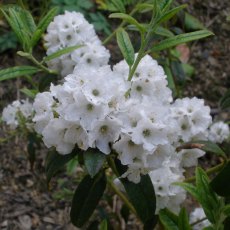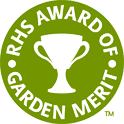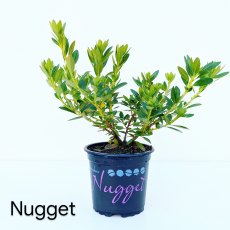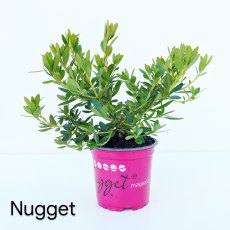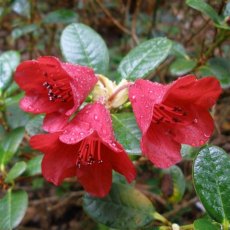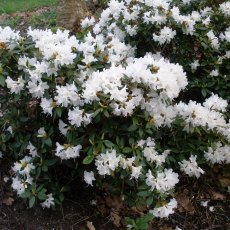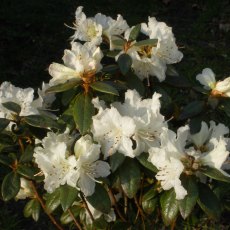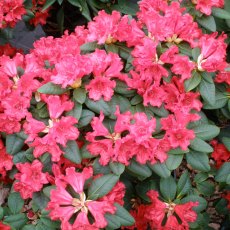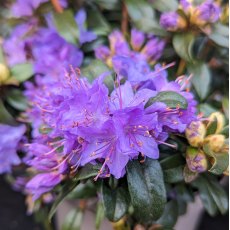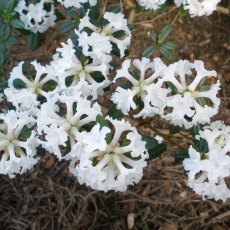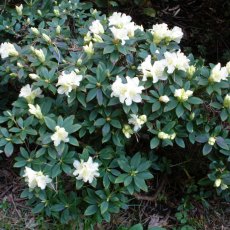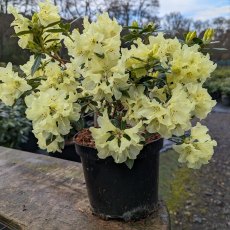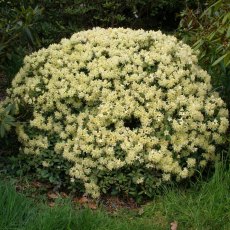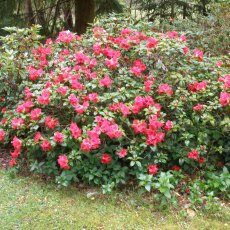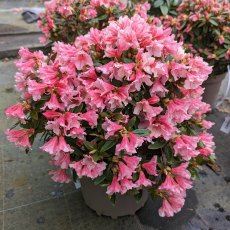Dwarf Rhododendrons
Tough alpine Rhododendrons for the front of borders which mainly flower in April.
These are mainly alpine varieties of rhododendron, and range from tiny gems such as Rhododendron keiskei 'Yaku Fairy', to larger growers up to heights of around 80 cm after 10 years. Being alpine plants, they prefer moist, cooler conditions, so hot sunny positions are best avoided. They mainly flower in April, and if space permits, they look great planted in groups of three.
Dwarf Rhododendron Arctic Tern AGM
(H5) Very attractive crowded trusses of pure white Ledum type flowers with a slightly green throat. Leaves are light green and thin and narrow. A most unusual late flowering compact dwarf for May-June. Height 50-60cm in 10 years.Dwarf Rhododendrons don't mind the sun but they hate too much heat, so do avoid reflected heat from South facing walls and patios, particularly if planting in containers. This...
Dwarf Rhododendron Bengal
(H5) Bright dark scarlet-red trumpet shaped flowers in a loose truss of 4-5 flowers. April flowering. Dark green leaves on a low compact spreading plant. A tough plant from Hobbie, Northern Germany. Height 25-50cm in 10 years.
• Recommended for: small gardens.• Easy to grow.• Ideal position: Some sun, away from heat.• Habit: Low, Compact, Spreading.• Group: Dwarf Rhododendron...
Dwarf Rhododendron Bloombux INKARHO
(H6) A wonderful flowering alternative to troublesome box hedging! Lots of clusters of soft pink flowers in June. The plant responds well to trimming after flowering. Height 50-75cm in 10 years. Easy to grow in most soils.
This superb new variety was raised by the INKARHO syndicate as 'Microhirs3' with PBR Plant Breeders Rights. It is suitable for growing on most garden soils, from very acidic...
Dwarf Rhododendron Bloombux Magenta INKARHO
(H6) A wonderful flowering alternative to troublesome box hedging! Lots of clusters of pink flowers in June. The plant responds well to trimming after flowering. Height 50-75cm in 10 years. Easy to grow in most soils.
This superb new variety was raised by the INKARHO syndicate as 'Microhirs3' with PBR Plant Breeders Rights. It is suitable for growing on most garden soils, from very acidic up...
Dwarf Rhododendron Carmen AGM
Stunning waxy dark red flowers in loose trusses in April. It has small glossy green leaves and we believe is one of the deepest red dwarfs available. Slow growing with a height 40cm and spread of 50cm in 10 years. Dwarf Rhododendrons don't mind the sun but they hate too much heat, so do avoid reflected heat from South facing walls and patios, particularly if planting in containers. This variety does...
Dwarf Rhododendron Crane AGM
With lovely pure creamy white flowers this pretty plant flowers in April. It is tough and very floriferous - a very popular plant that forms a neat dwarf mound. Height 40-60cm in 10 years. Dwarf Rhododendrons don't mind the sun but they hate too much heat, so do avoid reflected heat from South facing walls and patios, particularly if planting in containers. This is a tough plant and we think one of...
Dwarf Rhododendron Cream Crest
Lovely bright creamy yellow flowers in April. With a dense compact spreading habit this plant has great glossy deep green foliage. The flowers may need protection from spring frosts. Height 40-50cm in 10 years. Dwarf Rhododendrons don't mind the sun but they hate too much heat, so do avoid reflected heat from South facing walls and patios, particularly if planting in containers.
Recommended for...
Dwarf Rhododendron Egret AGM
Masses of pretty dainty white bell-shaped flowers in April. The flowers stand up high above the glossy mid green foliage. This is a compact neat growing plant, best in some sun to flower freely. Height 30-45cm in 10 years. Dwarf Rhododendrons don't mind the sun but they hate too much heat, so do avoid reflected heat from South facing walls and patios, particularly if planting in containers. One of...
Dwarf Rhododendron Elisabeth Hobbie AGM
(H5) Scarlet-red flowers with faint dark red spots in loose trusses. Flowering in April this plant is dense and compact and has wonderful rounded foliage. Height 60-80cm in 10 years. Dwarf Rhododendrons don't mind the sun but they hate too much heat, so do avoid reflected heat from South facing walls and patios, particularly if planting in containers. This is a tough plant but it dislikes too much...
Dwarf Rhododendron Gertrud Schale
(H5) Large waxy scarlet red flowers, in small trusses during April. Deep green leaves on a compact spreading plant, and one of the hardiest 'repens' hybrids, bred by D.G. Hobbie in Northern Germany. Height 25-50cm in 10 years.
Dwarf Rhododendrons don't mind the sun but they hate too much heat, so avoid reflected heat from South facing walls and patios, particularly if planting in containers.
Also...
Dwarf Rhododendron Gristede AGM
Stunning clusters of violet blue funnel-shaped flowers in April. This lovely plant has good shiny green winter's particularly hardy and easy to grow. Height 60-80cm in 10 years.
Dwarf Rhododendrons don't mind the sun but they hate too much heat, so do avoid reflected heat from South facing walls and patios, particularly if planting in containers. We love this plant and think it is one the best blue...
Dwarf Rhododendron Lavendula
(H5) Large deep lavender frilly flowers with darker spots, flowering in April. Dark green, highly scented, leaves turn bronze in winter. Very tough compact growing plant bred in Northern Germany. Height 50-75cm in 10 years. Requires moist acid soil.
• Recommended for: small gardens.• Easy to grow.• Ideal position: Sun or partial shade.• Habit: Shrub.• Group: Dwarf Rhododendron...
Dwarf Rhododendron Maricee
(H5) Cream buds open to white long-lasting daphne-like flowers. April. Tiny, narrow leaves on a dense, compact plant. An easy and satisfactory plant to grow. Height 30-40cm in 10 years.
Dwarf Rhododendrons don't mind the sun but they hate too much heat, so do avoid reflected heat from South facing walls and patios.
Recommended for rock gardens and front of borders.
Plantsman range.
Ideal position:...
Dwarf Rhododendron Patty Bee AGM
Large lemon yellow trumpet-shaped flowers in lax trusses of 6. Probably the best dwarf yellow available flowering in April. A compact plant with bronzy-plum winter foliage. Height 25-50cm in 10 years. Raised by that true Rhododendron enthusiast Warren Berg on the Olympic peninsula in Washington State, USA. Warren was a retired airline pilot and keen bee keeper who trekked in China with Ted and Romy...
Dwarf Rhododendron Peter Bee
(H6) Lovely funnel shaped pale yellow flowers, green in bud. Fine pale green narrow leaves. Flowering in April. A choice compact growing plant, raised by Warren Berg in America, and named by Peter Cox, Scotland. Height 25-50 cm in 10 years.
Dwarf Rhododendrons don't mind the sun but they hate too much heat, so do avoid reflected heat from South facing walls and patios, particularly if planting...
Dwarf Rhododendron Princess Anne AGM
Superb compact dwarf with small clear yellow flowers tinged green that appear in trusses of 4 to 10. This plant forms a free flowering mound in April/May on a plant with fresh green leaves, turning bronzey red in autumn with good winter foliage. Height 40-60cm in 10 years. Dwarf Rhododendrons don't mind the sun but they hate too much heat, so do avoid reflected heat from South facing walls and patios,...
Dwarf Rhododendron Robert Seleger
Lovely rose-purple flowers with darker edges in May. An interesting colour and flowering later than many other dwarf Rhododendrons, it has excellent foliage with pointed narrow leaves on a dense compact plant. Height 40-60cm in 10 years. Dwarf Rhododendrons don't mind the sun but they hate too much heat, so do avoid reflected heat from South facing walls and patios, particularly if planting in containers....
Dwarf Rhododendron Sacko
Excellent deep electric blue-purple flowers, freely produced in rounded trusses in April. This plant is a tough, neat and compact grower with good clean glossy foliage. Height 30-50cm in 10 years. Dwarf Rhododendrons don't mind the sun but they hate too much heat, so do avoid reflected heat from South facing walls and patios, particularly if planting in containers. This is a tough and easy plant and...
Dwarf Rhododendron Scarlet Wonder AGM
Stunning bright, cardinal red wavy-edged flowers appear in loose trusses in April. This is a free-flowering plant with attractive and distinctive glossy ribbed foliage. A neat growing plant which grows wider than high. Height 40-60cm in 10 years. Dwarf Rhododendrons don't mind the sun but they hate too much heat, so do avoid reflected heat from South facing walls and patios, particularly if planting...
Dwarf Rhododendron Wee Bee AGM
Red buds open to pretty rose pink tubular flowers, deeper pink on the outside, with red spotting in April. This is a superb low mounded plant with good foliage and a neat habit. In our opinion this is easily one of the best deep pink dwarf Rhododendrons. Height 30-50cm in 10 years. Raised by Warren Berg in Washington State USA, who was also a keen bee keeper! (See also Ginny Gee and Patty Bee). ...
Rhododendron Golden Wonder
Rhododendron Golden Wonder is a striking hardy dwarf and compact evergreen shrub. It is an easy to maintain shrub with lovely funnel shaped golden yellow flowers in April - May, followed by attractive winter foliage. Best planted in dappled shade, in well-draining, moist, slightly acidic soil. Also ideal for containers and small gardens. Height 25-50cm in 10 years.
Dwarf Rhododendrons don't mind...
 Millais Nurseries
Millais Nurseries


